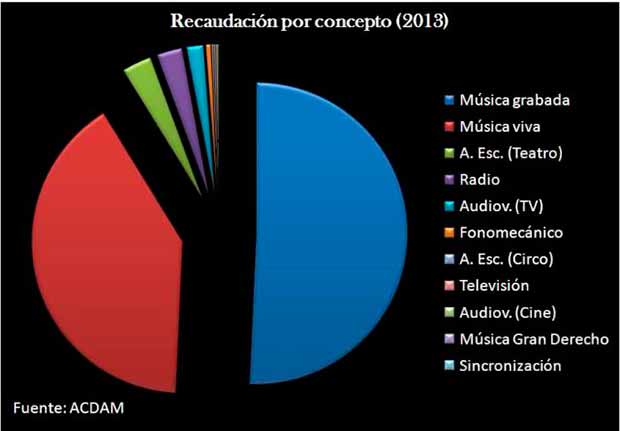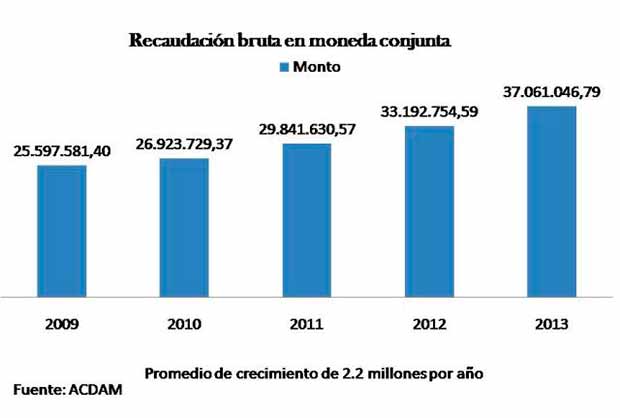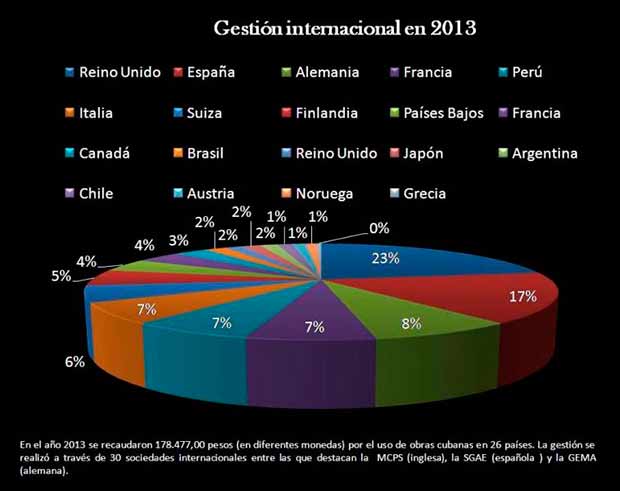How is the music market, managed from Cuba, performing? What singers, rights heirs, publishers or owners receive higher profits? What are the highest grossing songs?
– Of the more than 11,000 singers and owners of songs associated with you which is the highest-grossing today by copyrights?, I asked and the answer, in one of the offices of the Cuban Agency of Musical Copyright (ACDAM), headquartered in Havana, was immediate.
-Israel Rojas and Osmani Spinoza are some, Leonel Elias Perna, Assistant Director of Operations told OnCuba.
– And a third? … I insisted.
Decemer Bueno-he said-and-classics that never fall: Silvio, Pablo … and Matamoros, because even though it is not on the radio he is constantly played by trios. Everybody knows that Lagrimas Negras and Son de la loma are always looked for.
Leonel Elias Perna is a shrewd deputy, one of those skilled in doing math when you least expect it . On economics and business linked to the rights that generate the music and the performing arts in Cuba there are few Cubans as informed as him, especially of how well he knows the ropes in ACDAM, only entity on the island that protects the financial interests of authors, composers, publishers and other owners through the collection and distribution of royalties generated concerning the exploitation of their works.
The ACDAM has 11 700 members, most of them musicians and 330 are from performing arts. A look at the last five years (2009-2013) shows that the registering of authors in the state agency has grown, a new peak of 522 in 2012 , although in the case of registered works a reverse phenomenon is occurring: from 5751 in 2009 the figure dropped to 3865 last year.
According to information obtained from its latest report, in 2013 the gross revenues of this agency was more than 37 million pesos between the two currencies (national currency and convertible pesos).

A comparative analysis shows that, given the international average which indicates that more than 70% annual distribution in respect of the collection is a favorable indicator -ACDAM has a relative “good health” in their accounts. In 2009 and 2010 showed a 68, 32%; in 2011 went down to 67%, in 2012 amounted to 76% and in 2013 it was 84%.

Gross revenues in th currencies
– What about the songs? Which are the most profitable ones in recent years?.
– Highest grossing songs in the last decade are these:
Un montón de estrellas, by Fernando Borrego Linares (Polo Montañez)
Contigo en la distancia, by Cesar Portillo de la Luz
Lágrimas negras, by Miguel Matamoros
Chan Chan, by Francisco Repilado Muñoz Máximo (Compay Segundo)
Mamá son de la loma, by Miguel Matamoros
La gloria eres tú, by José Antonio Méndez García
Yolanda, by Pablo Milanés
Dos Gardenias, by Isolina Carrillo Díaz
Para bailar casino, by Adalberto Cecilio Álvarez Sayas
Guajira guantanamera, by José Fernández Díaz (Joseíto)
– Who is the heir who receives more profits?
– The son of Polo Montañez, he says and smiles.
It was to be expected. The singer Fernando Borrego Linares , better known as Polo Montañez , gave what in Cuba is often called a ” home run ” in the world of music. After being discovered in 1999 by José da Silva and the release in 2000 of his first album Guajiro Natural with the French label Lusafrica, he became an international star.
In Colombia, more than 40,000 copies were sold and, following that, during his three years of fleeting fame ( 2000-2002) – cut in by a sudden death, he shared the stage with artists such as Rubén Blades, Andy Montañez , Candido Fabre , Compay Segundo , Eliades Ochoa, Adalberto Alvarez, Danny Rivera and others. Marc Anthony and Gilberto Santa Rosa made versions of some of his songs .
– Speaking of Polo, a few months ago a rumor was circulating that Marc Anthony was interested in the rights of some of his songs…
‘That was false- heresponds quickly. In fact, the son of Polo who is his heir lives outside Cuba so Marc Anthony would not have to come here. Also, when an artist of that level comes to the island is not advertised that way because it can be interpreted in many ways. That happened to Beyoncé, people found out when they saw her on the street.
– What would be the advantages for an author or an heir to assign his rights to foreign publishers? I ask the lawyer Yanko Diaz Martinez
‘That depends. If an editor does promote you and fill an absence, a lack, you can get to a market, it may be advantageous because of the economic performance of the work generated by its use in many countries and in different modalities.
– Disadvantages for Cuba?
– There may be several, first to the author if the editor is not serious and fails to meet its contractual obligations and becomes a burden because he suffers economically of from the point of view of controlling their repertoire.
“And for the country because we talk about a Cuban work of which – in terms of right administration, Cuba loses control as heritage. If an author transfers his rights to a foreign company then who authorizes and controls the use of that work is the publisher or society beyond the economic implications and what the work generates on copyrights doesn’t return to the country if he has a bank account abroad, “he argues.
Currently, ACDAM has a Reciprocal Representation Agreement with the French company that oversees the exploitation of the work of the “Guajiro Natural “in the world, which means that the national entity is only responsible for collecting what is produced here .
This type of international agreement is a working strategy of the Cuban agency that now has more than 150 contracts in this mode, plus about 90 of Public Execution, about 60 of Mechanical Reproduction, among other documents signed with 93 international companies and 178 countries.

Their statistics show that major settlements from abroad, until 2013, come from copyright societies as APDAYC (Peru) and GEMA (Germany), but also had high amounts came from BUMA (Netherlands), JASRAC (Japan), APRA (Australia), TEOSTO (Finland) and SUISA (Switzerland).
But one of the main problems of ACDAM is that is not, as most of these agencies in the world, a collective management society. That means that is only dedicated to “receipts and payments” and do not represent, as some artists would like, all rights, that means, it doesn’t perform a custom management from the interests of its members, does not have a board of directors elected or given by its members, or have discretion over their funds.
– “The difference is huge,” the deputy says. And yet, being a public entity governed by the government, the results are relatively good.
In 2013 the provinces with the highest amounts of authors benefited from the payment for the exploitation of their rights were Havana, Holguin , Matanzas , Guantanamo , Sancti Spiritus, Ciego de Avila, Camagüey, Isla de la Juventud and Santiago de Cuba (in that order) . Of the musical labels, EGREM received the highest amount, then BISMUSIC and COLIBRI.
In percentages, the sectors that reported them more money were Gastronomy with 35%, the People’s Power with 20,193 % , with 16.81% Tourism and Culture with 13.31% . Of the rest, despite its nearly minimum, stand out Gaviota, CIMEX, ICRT , and ICAIC . Havana, Matanzas, Pinar del Rio, Holguin, Granma and Villa Clara provinces had the highest amounts in millions.
However, in the research “Bipolarity of the Cuban music industry: the conception of the common good and the use of the global market , published by the Association for the Study of the Cuban Economy ( ASCE) , explains that there are phenomena that have marked music marketing on the island :
The Special Period made necessary a new exploitation of the music in the tourism, with the 1992 Torricelli and Helms- Burton in 1996 Acts, adopted by the United States seriously affecting both Cuban artists and Cuban music industry, and to make things worse in the 90s, with the introduction of dual – currency system of national currencies, two distinct markets for the world of sound were created.
Today, the researcher Jesse Friedman explains – the goal for the music industry Cuba could be extended further expanding its presence in the market sectors and locations, as well as increasing the amount of its productions, for ” participation in fairs, festivals, concerts and international tours are opportunities for cultural exchanges and to recover funds for the dissemination of art abroad, but not to maximize profits. “
Cover image: Rainbow in Lagartoverde










